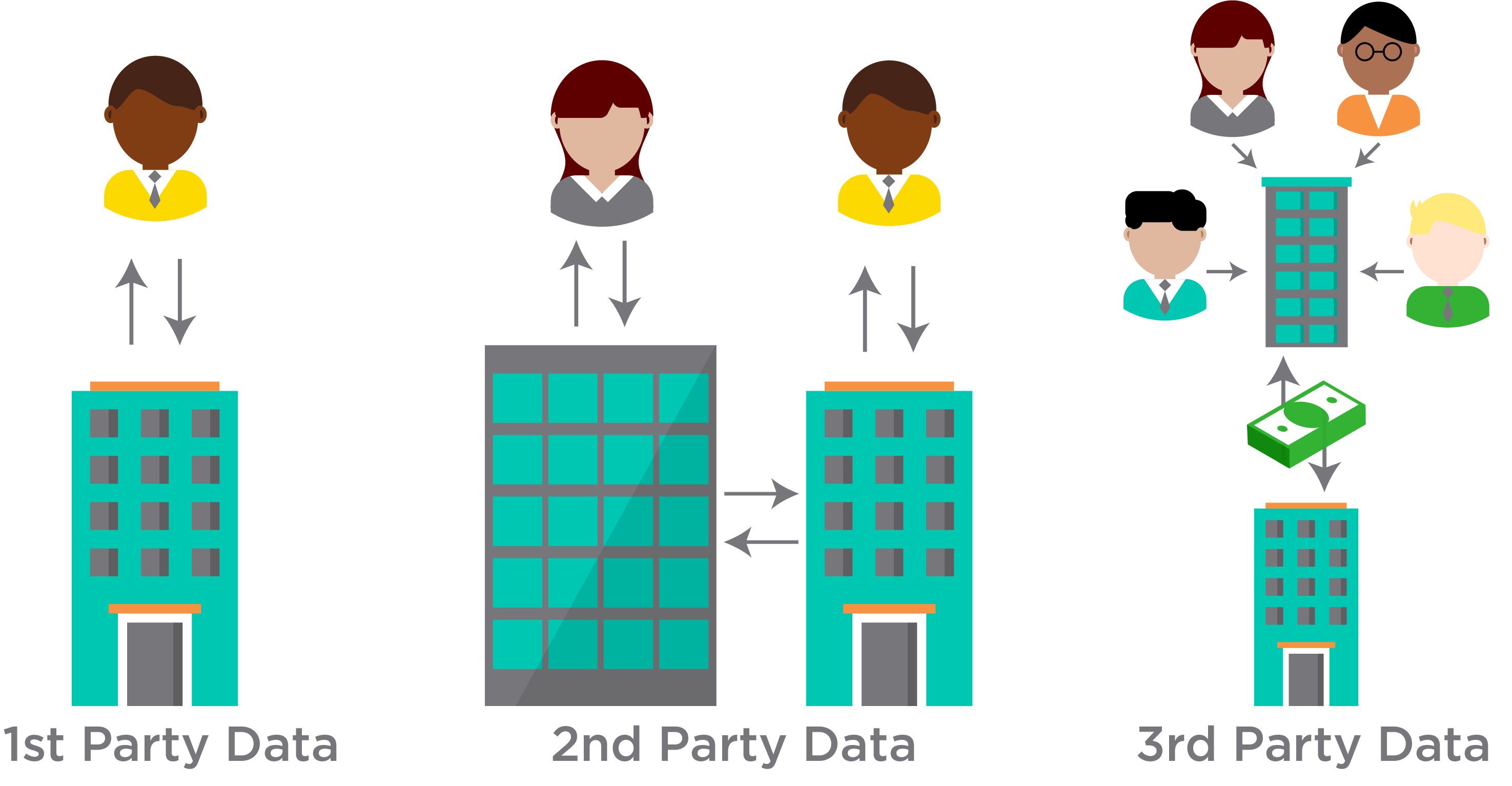A noticeable transformation is occurring in the realm of digital marketing. The impending decline of third-party cookies is transforming how businesses collect data and target ads to their audiences. This change, driven by increasing privacy concerns among users and regulatory restrictions, signals an end for these tracking tools that have been integral for ad tech companies. Major browsers like Safari and Firefox are already blocking third-party cookies by default, with Google Chrome planning to follow suit by the end of 2023.
Businesses and marketers are looking for ways to begin the pivot away from their reliance on third-party cookies for advertising. Direct mail is a tried-and-true method for getting marketing and advertising efforts into the hands of consumers. What was once considered a dwindling media form in the dawn of the digital age has now come full circle to being a beloved source of delivering personalized marketing for both consumers and businesses.
A Cookieless Future: The Changing Landscape of Digital Marketing
As we navigate towards this cookieless future, it brings along several challenges, especially for those who rely heavily on them as part of their digital advertising strategy. Without access to third-party data from cookies, delivering personalized display ads becomes more complex.
Digital marketers will need innovative solutions as traditional methods used in programmatic advertising may no longer be effective without these small pieces of code aiding targeted ad campaigns based on user behavior across multiple websites.

Rethinking Programmatic Advertising
In particular, demand-side platforms (DSPs), which facilitate the automated buying and selling process through real-time analysis using algorithms analyzing user behavior data, might find themselves needing alternative strategies since they won't be able to use traditional targeting methods anymore. Premium publishers, too, could feel the impact, considering such profiling techniques were often employed to maximize publisher revenue via tailored advertisements.
The digital advertising landscape is undergoing a seismic shift with the decline of third-party cookies. These tracking tools have been instrumental for ad targeting, offering crucial insights into user behavior and preferences. However, growing privacy concerns are pushing more users toward turning off third-party cookies. This change poses a significant obstacle to marketers who need to find alternative methods for data collection.
The new reality of third-party cookie tracking could be seen as an opportunity rather than a setback. Data concerns will force businesses to adopt more transparent, user-friendly ways of gathering information and fostering meaningful relationships with their target audience - enter direct mail marketing.
A New Era for Direct Mail
In contrast to the fleeting nature of display ads or pop-ups on our screens, direct mail offers something tangible that can leave lasting impressions on recipients. Forbes Agency Council suggests physicality plays a vital role in memory retention, making traditional mediums like print surprisingly effective even today amidst programmatic advertising strategies.
As the era of third-party cookies draws to a close, marketers are pivoting towards innovative alternatives. Beyond generic flyers or postcards lies creative direct mail - incorporating cutting-edge designs along with personalization techniques capable of driving up response rates significantly. With the advances in digital printing, each piece of direct mail can be individually tailored to the recipient using variable data printing without drastically increasing the printing costs.
Creative direct mail has proven its effectiveness in engaging target audiences. The statistics reveal an average response rate of 4.4% for direct mail, significantly higher than email marketing's meager 0.12%. Marketing Land's report suggests innovative types such as VR Viewers or 3D Holiday Cards can increase these numbers to around 8.5%, demonstrating how creativity coupled with technology is redefining what we traditionally understand about this medium.

Diving Deeper into Creative Direct Mail
Creative direct mail is gaining traction as it goes beyond traditional postcards or flyers; it involves captivating designs that draw attention and prompt recipient interaction. It all comes down to understanding your buyer personas well enough so you can craft targeted ads specifically designed for them through commercial printing services offered by companies like SunDance.
In today's privacy-conscious world, the renewed interest in physical media, combined with modern advancements, highlights how traditional methods can evolve without relying on online data collection practices. In the digital marketing space, trust is a commodity that can be difficult to obtain and quickly dissipate. As privacy concerns rise and third-party cookies fall out of favor, direct mail has re-emerged as an effective tool for building authentic connections with target audiences.
The tangible nature of direct mail fosters a sense of authenticity often missing in the digital world. Recipients can physically interact with your brand message - bypassing ad blockers or spam filters that may hinder other marketing efforts.
Fostering Authentic Connections While Maintaining User Privacy
Achieving personalization at scale is no small feat, but it's one where creative direct mail campaigns excel. Personalized content not only garners higher response rates compared to generic content but also makes recipients feel valued by a brand - leading to deeper engagement levels over time. By leveraging buyer personas, generational insights, or specific customer data points, such as past purchases or browsing behavior, businesses can create highly targeted ads that resonate deeply with their audience - driving better results than programmatic advertising based on third-party data alone could ever hope for.
Creative use of direct mail allows marketers to respect user privacy while delivering impactful messages effectively. Unlike strategies reliant on third-party cookies known for intrusive tracking practices, this approach provides personalized communication without compromising consumer preferences - ensuring your message gets delivered directly into potential customers' hands.
Beyond being another form of ad targeting, well-executed creative direct mail serves as memorable keepsakes rather than destined-for-the-trash-bin junk mail. Incorporating compelling copywriting coupled with eye-catching designs and embellishments encourages interaction from consumers who appreciate receiving something tangible they can hold onto. This kind of meaningful interaction nurtures loyalty among consumers, making them more likely to engage further down the line when considering future purchasing decisions, thereby increasing publisher revenue long term.

Making Direct Mail Interactive
You're not limited only to aesthetics; there's another major advantage: interactivity. Incorporating QR codes into the design, for example, marketers can connect offline efforts directly back to online content, providing a seamless transition between mediums while still capturing essential third-party data needed for targeting future ad campaigns effectively.
Possibilities here are endless, from linking users directly to product pages, encouraging immediate purchase action, to scanning codes that lead to educational resources, deepening understanding of brand offerings, and ultimately fostering a stronger relationship with the potential customer base. All factors combined make a clear case for how much value creative direct mail provides, both in terms of customer engagement and ROI perspective, making it an indispensable part.
Balancing Data Collection with User Privacy
The shift towards a cookieless future has prompted marketers to rethink their strategies. The growing emphasis on privacy demands that businesses balance effective data collection with respect for user rights. In the world of ad targeting and programmatic advertising, third-party cookies have been indispensable tools. But as browsers increasingly block these tracking mechanisms, advertisers must find ways to gather valuable insights without infringing upon users' online privacy.
A promising approach lies in focusing on first-party data - information collected directly from your customers or website visitors. While this type of data might be less abundant than its third-party counterpart, it is often more accurate and relevant because it originates straight from the source: your audience.
Another strategy involves contextual advertising, which targets ads based on what content a user is viewing at any given moment rather than relying heavily on personal details about them. For instance, an advertisement promoting running shoes would make sense to appear within fitness-related blog posts or articles discussing athletic activities. Contextual advertising is a less invasive yet equally effective method of reaching out when interest levels are already high without compromising trust between brands and customers.

A Shift Towards First-Party Data
Third-party cookies, which have seen a decline in recent times, are forcing marketers to reevaluate their strategies and embrace more privacy-focused digital marketing. As major browsers like Google Chrome and Safari continue their move towards blocking these cookies, marketers are being compelled to revise their strategies.
This transition from cookie-based advertising is paving the way for an era where privacy-centric approaches dominate digital marketing. It's not just about adhering to regulations such as GDPR or CCPA; it also entails respecting user privacy while still delivering targeted ads that resonate with audiences.
We can anticipate more significant reliance on first-party data in the coming years. This data type comes directly from your audience - they've willingly provided this information through actions or behaviors demonstrated across your website, subscriptions, social media profiles, and other owned channels. First-party data, therefore, provides more reliable insights into ad targeting than third-party sources ever could.
To leverage first-hand information effectively in our future strategies requires understanding its quality and reliability over traditional methods used by many ad tech companies today. With changes around every corner, quickly adapting will be key moving forward.
Leveraging Direct Mail Amidst Digital Strategy Shifts
To navigate changes in internet privacy norms effectively requires incorporating innovative approaches into digital marketing efforts like direct mail campaigns - physical addresses are not considered personally identifiable information (PII), thus making them less prone to changing regulations around web-based confidentiality rules.
Creative direct mail presents brands with an opportunity to not only engage with their target audiences but also to stand out amidst the countless display ads competing for attention across various platforms every day. When executed well, direct mail campaigns can generate higher response rates than traditional email marketing methods. The increase in engagement is primarily due to direct mail's tangible nature, which compels recipients to take notice, unlike emails, which can be easily ignored or deleted.

FAQs in Relation to Direct Mail as a Replacement for 3rd Party Cookie Advertising 🍪
🍪 What will replace 3rd party cookies?
Direct mail, first-party data collection, and privacy-focused technologies like Federated Learning of Cohorts (FLoC) are poised to replace third-party cookies.
🍪 How do I advertise without third-party cookies?
You can leverage direct mail campaigns, contextual advertising based on the site's content, or use consent-based first-party data for personalized marketing.
🍪 Are third-party cookies going away?
Yes. Major browsers like Chrome plan to phase out support for third-party cookies by the end of 2023 due to increasing privacy concerns.
🍪 Is there an alternative to cookies?
Besides direct mail, alternatives include using first-party data collected with user consent and new technologies, such as Google's FLoC, that respect user privacy.
Choose SunDance for Your Next Direct Mail Campaign
The landscape of digital marketing is shifting, and the decline of third-party cookies presents new challenges. Enter direct mail, rising like a phoenix from the ashes of cookie-based advertising. Creative designs. Personalization. High response rates. That's what direct mail brings to the table. This isn't your grandma's junk mail; it's targeted communication that builds trust without invading privacy.
In this oversaturated digital world, creative direct mail stands out and provides genuine value to customers. As we adapt our strategies for online privacy changes, balancing data collection with user respect becomes paramount. The future outlook? It's clear: Direct Mail is reaffirming its importance in the post-cookie era.
With our expertise in creative design, commercial printing, mailing list acquisition, and direct mail campaigns, SunDance is here to guide you through every step of your next mailing project!
Are you ready to explore how SunDance can help your business leverage direct mail as a replacement for 3rd party cookie advertising? Give us a call at 407.734.7444 or contact us!












